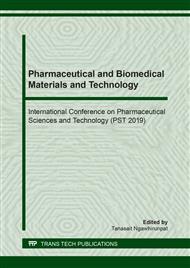[1]
G. Amoabediny, F. Haghiralsadat, S. Naderinezhad, M.N. Helder, E. Akhoundi Kharanaghi, J. Mohammadnejad Arough, B. Zandieh-Doulabi, Overview of preparation methods of polymeric and lipid-based (niosome, solid lipid, liposome) nanoparticles: a comprehensive review, Int J Polym. Mater. Po. 67 (2018) 383-400.
DOI: 10.1080/00914037.2017.1332623
Google Scholar
[2]
K.M. Kazi, A.S. Mandal, N. Biswas, A. Guha, S. Chatterjee, M. Behera, K. Kuotsu, Niosome: a future of targeted drug delivery systems, J Adv Pharm. Technol. Res. 1 (2010) 374-380.
DOI: 10.4103/0110-5558.76435
Google Scholar
[3]
O. Paecharoenchai, N. Niyomtham, L. Leksantikul, T. Ngawhirunpat, T. Rojanarata, B.-e. Yingyongnarongkul, P. Opanasopit, Nonionic surfactant vesicles composed of novel spermine-derivative cationic lipids as an effective gene carrier in vitro, AAPS PharmSciTech 15 (2014) 722-730.
DOI: 10.1208/s12249-014-0095-x
Google Scholar
[4]
P. Opanasopit, L. Leksantikul, N. Niyomtham, T. Rojanarata, T. Ngawhirunpat, B.E. Yingyongnarongkul, Cationic niosomes an effective gene carrier composed of novel spermine-derivative cationic lipids: effect of central core structures, Pharm Dev Technol. 22 (2017) 350-359.
DOI: 10.3109/10837450.2015.1125925
Google Scholar
[5]
E. Junquera, E. Aicart, Recent progress in gene therapy to deliver nucleic acids with multivalent cationic vectors, Adv Colloid Interface Sci. 233 (2016) 161-175.
DOI: 10.1016/j.cis.2015.07.003
Google Scholar
[6]
S. Mochizuki, N. Kanegae, K. Nishina, Y. Kamikawa, K. Koiwai, H. Masunaga, K. Sakurai, The role of the helper lipid dioleoylphosphatidylethanolamine (DOPE) for DNA transfection cooperating with a cationic lipid bearing ethylenediamine, Biochim Biophys Acta Biomembr. 1828 (2013) 412-418.
DOI: 10.1016/j.bbamem.2012.10.017
Google Scholar
[7]
E. Ojeda, G. Puras, M. Agirre, J. Zarate, S. Grijalvo, R. Eritja, G. Martinez-Navarrete, C. Soto-Sánchez, A. Diaz-Tahoces, M. Aviles-Trigueros, E. Fernández, J.L. Pedraz, The influence of the polar head-group of synthetic cationic lipids on the transfection efficiency mediated by niosomes in rat retina and brain, Biomaterials. 77 (2016) 267-279.
DOI: 10.1016/j.biomaterials.2015.11.017
Google Scholar
[8]
V.B. Junyaprasert, V. Teeranachaideekul, T. Supaperm, Effect of charged and non-ionic membrane additives on physicochemical properties and stability of niosomes, AAPS PharmSciTech. 9 (2008) 851.
DOI: 10.1208/s12249-008-9121-1
Google Scholar
[9]
K.B. Knudsen, H. Northeved, P. Kumar Ek, A. Permin, T. Gjetting, T.L. Andresen, S. Larsen, K.M. Wegener, J. Lykkesfeldt, K. Jantzen, S. Loft, P. Møller, M. Roursgaard, In vivo toxicity of cationic micelles and liposomes, Nanomed Nanotechnol. Biology and Medicine, 11 (2015) 467-477.
DOI: 10.1016/j.nano.2014.08.004
Google Scholar
[10]
L. Xu, M.F. Wempe, T.J. Anchordoquy, The effect of cholesterol domains on PEGylated liposomal gene delivery in vitro, Ther Deliv. 2 (2011) 451-460.
DOI: 10.4155/tde.11.13
Google Scholar
[11]
J. Tang, L. Zhang, H. Fu, Q. Kuang, H. Gao, Z. Zhang, Q. He, A detachable coating of cholesterol-anchored PEG improves tumor targeting of cell-penetrating peptide-modified liposomes, Acta Pharm Sin B. 4 (2014) 67-73.
DOI: 10.1016/j.apsb.2013.12.004
Google Scholar
[12]
T.C. Lai, Y. Bae, T. Yoshida, K. Kataoka, G.S. Kwon, pH-sensitive multi-pegylated block copolymer as a bioresponsive pdna delivery vector, Pharm. Res. 27 (2010) 2260-2273.
DOI: 10.1007/s11095-010-0092-z
Google Scholar
[13]
S. Alhaji, E. Chowdhury, R. Rosli, F. Hassan, S. Abdullah, Gene delivery potential of biofunctional carbonate apatite nanoparticles in lungs, BioMed Res. Int. 2014 (2014) 1-12.
DOI: 10.1155/2014/646787
Google Scholar


